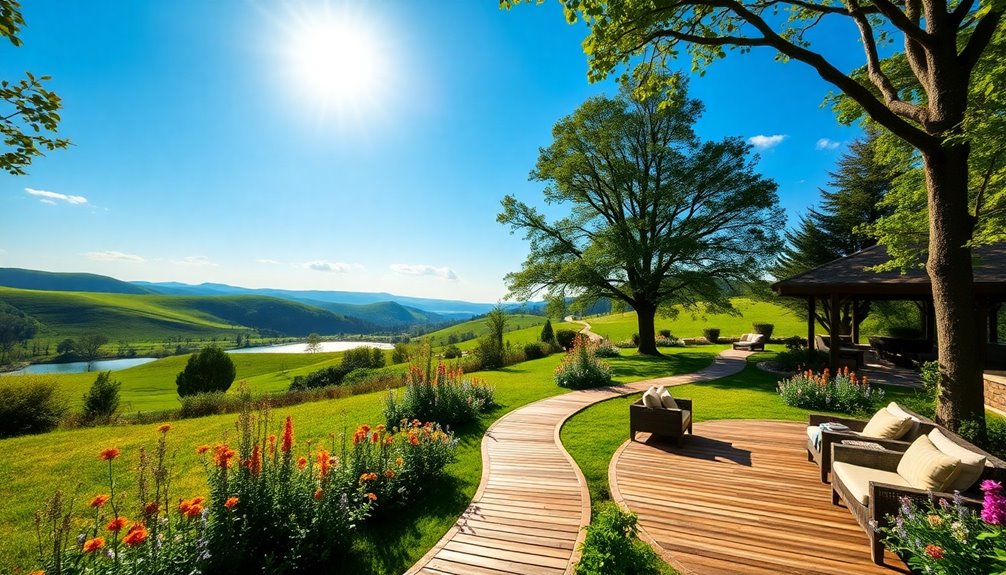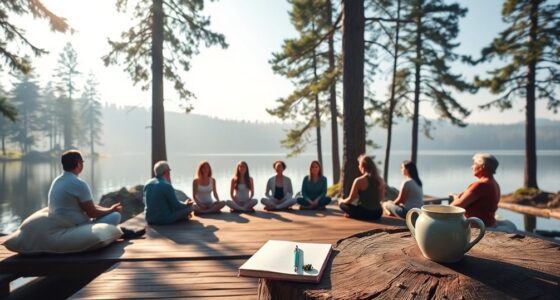To design a retreat center that exudes tranquility, start by defining your core concept and understanding your target audience. Choose a serene location that connects guests with nature, and create inviting spaces using natural elements and calming colors. Integrate essential amenities like wellness facilities, comfortable accommodations, and outdoor areas for activities such as meditation. Focus on personalized experiences that cater to individual needs, which enhances guest satisfaction. Ultimately, implement effective marketing strategies to attract your ideal audience. You'll discover even more insights and strategies to help you create the perfect retreat center as you explore further.
Key Takeaways
- Define a unique retreat concept that resonates with your target audience, enhancing personal growth and community connection.
- Choose a serene, nature-rich location that promotes relaxation and is accessible to transport hubs for convenience.
- Design inviting spaces using natural elements, calming colors, and comfortable amenities to foster tranquility and emotional well-being.
- Personalize guest experiences through tailored programs, community-building activities, and nutritious meal options focusing on wellness.
- Implement effective marketing strategies, including social media engagement and collaboration with influencers, to attract the ideal audience.
Identifying Your Retreat Concept

When you're designing a retreat center, identifying your core concept is essential, as it sets the tone for the entire experience.
Your retreat concept should resonate with your target audience, whether it's focused on meditation, yoga, or holistic wellness. By narrowing down your theme, you create a framework that enhances guest satisfaction and personal growth.
Consider what unique offerings you can provide, like community connection or experiential learning, which can enrich their experience.
Remember, guests today prefer personalized experiences over generic ones, so think about how you can tailor your approach to meet their specific needs.
A well-defined retreat concept not only attracts your ideal audience but also differentiates you in a competitive market.
Understanding Your Target Audience

To create a successful retreat center, you need to identify your target audience segments and their key preferences. Understanding what different groups seek will help you tailor experiences that align with their specific needs. This focused approach guarantees your offerings resonate and provide a fulfilling experience for your guests. Additionally, incorporating mindfulness techniques into your retreat programs can enhance the overall experience and promote relaxation among participants.
Defining Audience Segments
How can you guarantee your retreat center meets the needs of diverse groups? Start by defining your target audiences. Different segments—corporate teams, wellness seekers, and spiritual enthusiasts—have unique preferences and requirements.
For example, stress relief seekers might prioritize tranquil settings and wellness workshops, while corporate clients look for team-building activities and accessible locations.
Consider demographic-specific retreats, like women's or couples' retreats, to enhance satisfaction by addressing their distinct experiences.
Understanding audience behavior trends is essential, too; many now seek personalized and transformative retreat experiences.
Engage potential attendees through surveys or polls to gather valuable insights about their interests and expectations. This information is key when planning your spiritual retreat, allowing you to create a meaningful and enriching experience for all.
Identifying Key Preferences
Gathering insights about your target audience's key preferences is essential for designing a successful retreat center. Understanding what potential guests seek—whether it's relaxation, spiritual growth, or team-building—will guide your offerings and activities.
Here are three steps to help you identify these preferences:
- Conduct Surveys: Poll your audience to learn their interests and needs related to retreat goals.
- Analyze Demographics: Different age groups often gravitate towards unique experiences; younger guests may prefer adventure, while older clients might value wellness.
- Stay Trend-Savvy: Keep up with market trends, like the demand for eco-friendly practices, to attract environmentally conscious attendees. Additionally, consider the importance of safe sleep practices for guests who may be bringing newborns along for the retreat.
Tailoring Experiences Accordingly
While understanding your target audience is essential for creating a successful retreat center, tailoring experiences to meet their diverse needs can elevate their overall satisfaction. Conduct market research to pinpoint interests, stressors, and preferences, allowing you to customize the guest experience. Given that 70% of wellness travelers favor personalized experiences, offering varied programming is key. Additionally, incorporating elements such as interactive sessions can create memorable experiences that resonate with guests.
| Demographic | Tailored Experience |
|---|---|
| Corporate Teams | Team-building workshops |
| Wellness Seekers | Yoga and meditation sessions |
| Spiritual Enthusiasts | Guided nature walks |
| Community Seekers | Communal meals and activities |
Choosing the Ideal Location

Choosing the ideal location for your retreat center not only sets the tone for the experience but also plays a crucial role in attracting the right guests. A serene, nature-rich environment enhances tranquility and connection to the outdoors, fundamental for relaxation.
Here are three key considerations:
- Accessibility: Confirm your site is near transport hubs, minimizing urban distractions for easy arrival and unwinding.
- Target Audience: Consider the preferences of your guests—luxury or rustic accommodations can cater to different demographics.
- Facilities: Make certain the location can accommodate essential amenities like yoga decks and communal spaces, crucial for a holistic retreat experience in the growing wellness tourism market. Additionally, incorporating fermented vegetables into your retreat's dining options can promote gut health and enhance the overall wellness experience for attendees.
Designing for Tranquility

To create a tranquil retreat center, you'll want to incorporate natural elements like water features and greenery that promote relaxation.
Pairing these with calming color palettes, such as soft blues and greens, can help foster a serene atmosphere.
Together, these design choices will enhance the overall experience for your guests, allowing them to unwind and connect with their surroundings. Additionally, incorporating natural elements like rocks and sand can further promote mindfulness and tranquility.
Natural Elements Integration
Integrating natural elements into your retreat center design not only enhances tranquility but also fosters a deep connection to the surrounding environment.
By incorporating features that promote relaxation, you create an inviting wellness retreat.
Consider these three aspects for integrating natural elements:
- Water Features: Add calming sounds of flowing water to create a peaceful ambiance.
- Natural Light: Use large windows and skylights to fill spaces with sunlight, supporting your guests' circadian rhythms.
- Outdoor Spaces: Design areas for meditation and yoga, allowing participants to immerse themselves in a serene natural setting.
These elements not only beautify your center but also align with the ethos of environmental consciousness, ensuring a holistic experience for every visitor. Additionally, incorporating essential oils can further enhance the atmosphere, promoting relaxation and emotional wellbeing for your guests.
Calming Color Palettes
Natural elements play a significant role in creating a serene atmosphere, but the color palette you select can further enhance that tranquility.
Opt for calming color palettes like soft blues, gentle greens, and earthy neutrals to reduce stress and promote relaxation. Shades such as lavender and pale yellow can elevate feelings of happiness and tranquility, making your retreat center a peaceful haven for personal reflection.
Incorporate nature-inspired hues to strengthen the connection to the outdoors. A monochromatic scheme with varying shades of a single color fosters a cohesive environment, essential for mindfulness. Additionally, using colors that align with the Law of Attraction can help create an inviting space that encourages positive thoughts and emotional alignment.
Integrating Essential Amenities

Creating a welcoming retreat center hinges on the thoughtful integration of essential amenities that enhance the overall experience. By focusing on key elements, you can guarantee guests feel relaxed and rejuvenated.
- Accommodations: Offer comfortable spaces, like private rooms or shared dormitory-style settings, to foster relaxation and community.
- Wellness Facilities: Incorporate treatment rooms for massage, reiki, or sound healing, providing guests with holistic therapies that promote healing.
- Group Activities: Design multipurpose halls or workshop areas to host classes, discussions, and creative sessions, facilitating personal growth and engagement. Additionally, consider how Bitcoin IRAs can be a unique way to provide financial education and investment opportunities for guests interested in alternative assets.
Budgeting and Financial Planning

After establishing the right amenities for your retreat center, it's time to tackle budgeting and financial planning.
Start by setting a startup budget, which typically ranges from $20,000 to $500,000, depending on your location, size, and the amenities you offer.
Identify and categorize the costs involved, including property expenses, utilities, staffing, and supplies. A solid financial plan will help guarantee you cover all bases.
Regularly track your income and expenses to analyze profitability and set clear financial goals.
Don't forget to explore diverse funding options like loans or grants to secure necessary capital.
Finally, prepare for seasonal fluctuations in attendance to maintain cash flow and sustain operations year-round. Additionally, consider establishing an emergency fund to buffer against unexpected expenses or downturns in guest bookings.
Marketing Your Retreat Center

How can you effectively market your retreat center to attract the right guests? A solid marketing strategy is essential for increasing retreat bookings and creating a loyal clientele.
- Build an Engaging Website: Create a visually appealing site detailing your amenities, programs, and contact information to capture potential guests' interest.
- Leverage Social Media: Use platforms like Instagram and Facebook to share stunning visuals and authentic testimonials that highlight your retreat's unique offerings.
- Email Marketing: Regularly send targeted emails to keep past and prospective guests updated on upcoming retreats and special offers.
Collaborate with wellness influencers for greater credibility, and attend industry events to network and promote your retreat center effectively.
Frequently Asked Questions
What Should I Look for in a Retreat Center?
When you're looking for a retreat center, focus on serene natural surroundings that promote relaxation.
Check for a variety of indoor and outdoor spaces to facilitate different activities, and guarantee the center can comfortably accommodate your group.
Look for essential amenities like kitchens, wellness facilities, and cozy lodging.
Finally, choose a venue with experience in hosting similar events, as this will help streamline your planning and enhance the overall experience.
How Do You Structure a Spiritual Retreat?
To structure a spiritual retreat, start by defining a clear theme that resonates with your participants, like mindfulness or healing.
Create an itinerary that balances structured activities, such as meditation and workshops, with free time for personal exploration.
Incorporate diverse practices, like yoga or nature walks, to cater to different preferences.
Confirm you provide comfortable accommodations and nourishing meals, fostering community and enhancing well-being throughout the retreat experience.
Gather feedback post-retreat to improve future events.
How to Make a Retreat Program?
To make a retreat program, start by defining your core theme and objectives, whether it's wellness, spirituality, or creativity.
Create a balanced itinerary that combines structured activities with relaxation and communal time. Incorporate engaging activities like yoga, meditation, or nature walks to encourage personal growth and connection.
Don't forget to leave room for flexibility, allowing spontaneous interactions.
Finally, gather feedback post-retreat to refine and improve future programs, ensuring everyone's needs are met.
How Much Does It Cost to Build a Retreat Center?
So, you think building a retreat center is a walk in the park? Well, brace yourself!
Costs can range from $20,000 to $500,000, influenced by location, size, and amenities. Land prices can skyrocket, especially near attractions. Plus, larger venues come with higher operational costs.
Sure, eco-friendly features attract upscale clients, but they'll drain your wallet upfront.
Consider starting small and managing your budget wisely to make your dream a reality without breaking the bank.
Conclusion
In designing your retreat center, remember that every choice you make can create a ripple of tranquility. You might find that the perfect location unexpectedly aligns with your vision, or that your target audience resonates deeply with your unique concept. Embrace the coincidences that guide you, and trust your instincts. As you weave together the elements of design, amenities, and marketing, you'll cultivate a serene sanctuary that invites rejuvenation and connection, turning dreams into reality.









